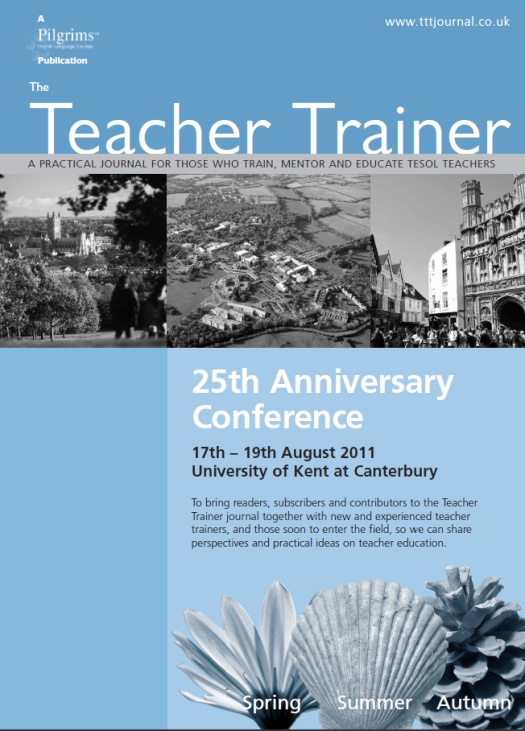Dear HLT Readers,
Welcome to the new issue of HLT. The Pilgrims summer is barely over, and we are already thinking about next year. There are many new courses for you to choose from next year. One of them is Skilled Helping and Feedback a brand new Pilgrims course designed by Adrian Underhill. For more courses to choose from for Easter and the summer of 2011 go to our website:

Pilgrims courses can be truly inspiring. In Working with Realia by Anette Kurz you can read about an idea for the classroom inspired by a Pilgrims course and the setting in Canterbury.
In this issue you will find a number of articles on teaching theories and classroom practice. In major article Fostering Language Acquisition: Task Based Lesson and Vehicular Use of FL/SL in the Italian Education System, Barbara Sinisi looks at the discrepancy between the widely accepted methodological framework, such as the communicative and task-based approaches and the actual practice in Italian schools. In Rudolf Steiner and ELT? A Reply to Tony Cañadas’ Article Stefan Rathert takes an issue with some views about Waldorff schools and the various interpretations and applications of Steiner theories. In The Heart of the Matter: A Short Personal History of SLA Research and What It Has Meant to My Classroom Teaching – Part One Lou Spaventa shares with you his personal experience when trying to combine theory and practice.
The subject of classroom practice is discussed in Why Teach Music Well and Language Badly in China? by Mario Rinvolucri who wonders how it is possible that some subjects can be taught perfectly while language teaching is foul. It is amazing how excellent practice in one subject cannot travel into another. The article calls for more communication among educators. Andrew Wright in Language Teachers or Communication Teachers? talks about how teachers neglect typeface or page design of their materials. As an editor and a very visual person I can only cheer when I read this article. I know how sometimes layout can be a real an eyesore and a distractor. In the same way our learners may be really concerned if the texts are not neat and elegant. What is more, I believe this non-verbal aspect extends to the visual material our learners are exposed to Coursebooks are full of cheap, photoshop-like photography. My dear friend, a renown photographer married to an ELT teacher, tears his hair out when looking at the photos and visual aspect of ELT coursebooks. We do need to care more of the non-verbal sphere!


There is a strong humanistic angle in Autorhythmy- Part 2 and Part 3, in which Mihály Hevesi focuses on how to be present in a text and why this is so critical, and how to understand a text in a foreign language without a dictionary. Another related article is The Advantages of Learning a Dominant Language: Addressing the Integrity of Individuals by Miguel Mantero and David Backer, who look at the humanistic side of learning.
There are also six voices on different teaching situations and the authors’ reflections: An Overview of Business Culture Awareness Abroad by Alan Green and Eberhard Oehler, Teaching Busy Adults: Balancing Upstream/Downstream Notions by Irina Khan, General Remarks on Second Language Acquisition by Adam Borowski, A Fresh Start at School - Fresh Students? by Małgorzata Oberg, BRITALY – Some Observations Jane Hedworth, and Studying Science or Studying Humanities – Which Makes You a Better Language Learner? by Irina Dementjeva. To balance the teachers’ views there is a fascinating student’s voice: My life is C+ by Adcharawan Buripakdi from Thailand.
When it comes to activities and designing materials, in A Language Garden in the Desert: Bustan Al Qusas, David Vale introduces us to an innovative project in which teachers undertook to create original and traditional stories, related to didactic materials to support teaching language and literacy in primary schools and kindergartens. For those interested in teaching higher levels there is Using Creative Writing in Developing Language Proficiency, by Alena Štulajterová.
There are a few articles related to the use of IT and blended learning in class: Initiating Change Using Wiki for EAP Writing in Technology-poor Nigeria by Peter Aborisade and Why Is It Worth Teaching and Learning Literature Online? by Claudio de Paiva Franco and Arda Arikan. In Word Clouds for Chunks you can read more on how to use some available web tools for creative classroom activities and in Short Book Reviews you can find a review of a book linked to an impressive teaching website.
There are some lesson outlines for you to choose from. In tune with the season there is: Halloween: Activating your Memory through your Senses! by Lauren Damas, two ideas on using furniture creatively: Musical Chairs by Sezgi Yalin and The Furniture Experience by Danny Singh, and two classic activities: Irregular Verbs Rods Game by Paco Francia and An Old Exercise by Paul Davis.
If you would like to get some update on some developments in the publishing world read: QSE: A Skills-based ELT Course with Conversation, CLIL and Exam Practice, and Basic Multiple Intelligences for EFL Teachers.
For your entertainment there are Jokes and some poems (Three Trashcans by Svetlana Lavochkina, The Enemy Within by Ibn Tyne, and Cities: Poems from an Oxford Summer, 2008).
Enjoy the new issue of HLT
Hania Kryszewska
HLT Editor
hania.kryszewska@pilgrims.co.uk



|